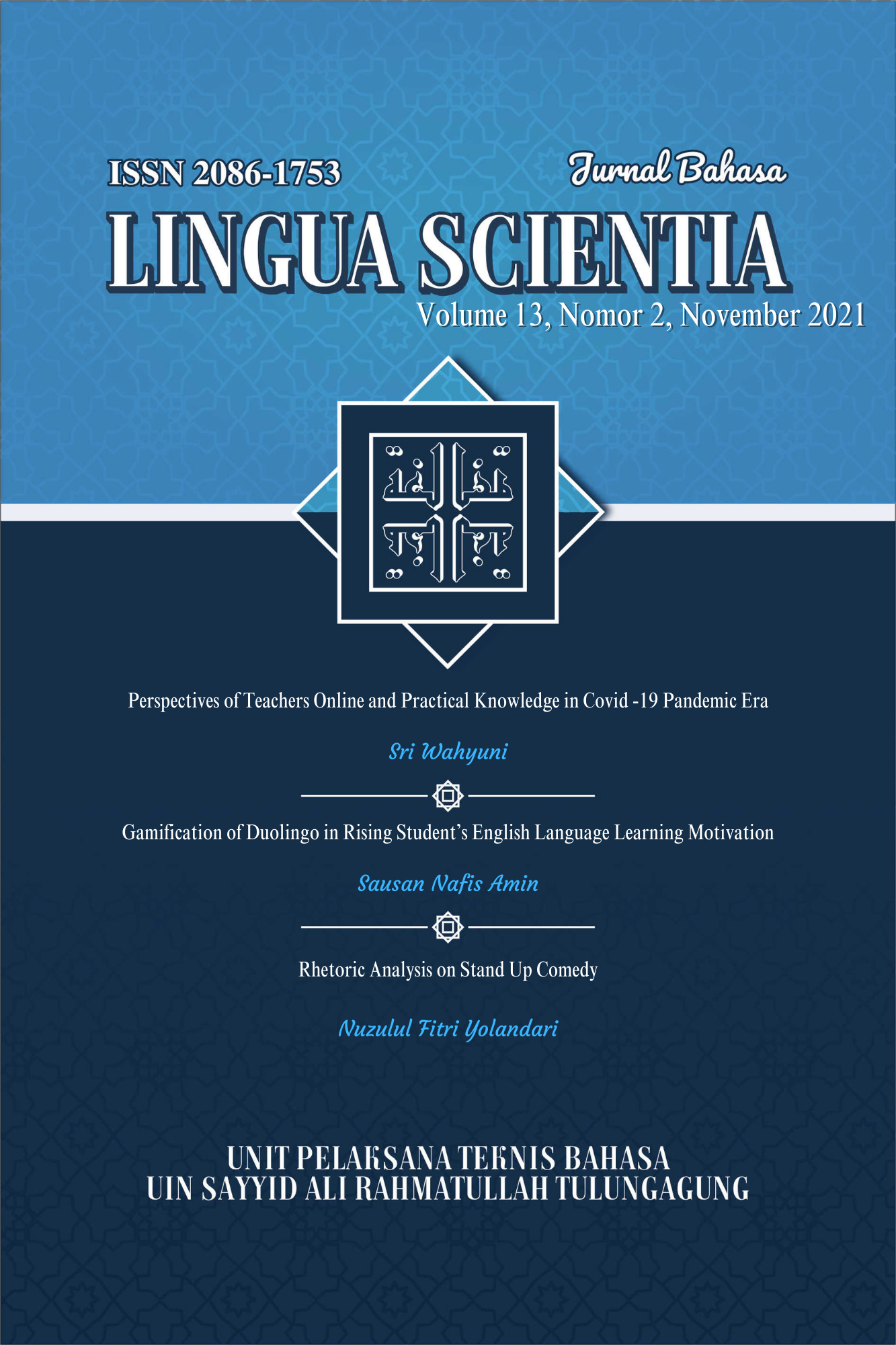GAMIFICATION OF DUOLINGO IN RISING STUDENT’S ENGLISH LANGUAGE LEARNING MOTIVATION
Abstract
This study aims to identify students' motivation in learning English through the Duolingo application, its effects, and what makes it different from conventional learning. The Duolingo application is free language acquisition and education for the world. The term acquisition itself is interpreted differently by language researchers. Some researchers distinguish between obtaining and learning. On the other hand, other researchers consider the term to be the same. In this study, researchers refer to the idea that they are the same. In conducting this research, researchers used case studies to analyze data. The researchers were selected five students of second-grade SMK Ngunut 1 Tulungagung who play of Duolingo application to get their second language motivation. Data was collected by direct observation and in-depth interviews with subjects who had two learning language experiences such as books and learning applications. The reason why choosing games as a factor in improving English learning in this study is because games have become one of the results of the development of popular technology in the community.
Downloads
References
Arsyad, A. (2011). Media Pembelajaran. Jakarta: Raja Grafika Persada
Bahjet Essa Ahmed, Heba, Duolingo as a Bilingual Learning App: A Case Study (July 26, 2016). Arab World English Journal (AWEJ) Volume.7 Number.2 June, 2016 AvailableatSSRN: https://ssrn.com/abstract=2814822or http://dx.doi.org/10.2139/ssr 2814822
Blake, R. (2016). Technology and the four skills. In Language Learning and Technology.
cheng. (n.d.). A Mobile Device and Online System with Contextual Familiarity and its Effec: EBSCOhost. Retrieved July 31, 2018, from http://web.a.ebscohost.com/ehost/pdfviewer/pdfviewer?vid=0&sid=424c115f -a0d2-4ca7-aa51-2d8007682d9a%40sessionmgr4008
Clarke, I., Flaherty, T. B., & Mottner, S. (2001). Student Perceptions of Educational Technology Tools. Journal of Marketing Education, 23(3), 169–177. https://doi.org/10.1177/0273475301233002
Csizér, K., & Dörnyei, Z. (2005). The internal structure of language learning motivation and its relationship with language choice and learning effort. Modern Language Journal. https://doi.org/10.1111/j.0026-7902.2005.00263.x
Deterding, S., Dixon, D., Khaled, R., Nacke, L. (2011). From game design elements to gamefulness: defining “gamification”. In: 15th International Academic MindTrek Conference: Envisioning Future Media Environments, pp. 9–15
Dillenbourg, P. (1999). What do you mean by collaborative learning? Dillenbourg, P. (ed.). Collaborative-Learning: Cognitive and Computational Approaches. Oxford: Elsevier, 1-19.
Duolingo. (2016). Retrieved January 15, 2016, from http://www.duolingo.com/
Gamification Teardown: Duolingo. https://blog.captainup.com/how-gamificationmakes- language-learning-even-more-awesome-on-duolingo/
Garcia, I. (2013). Learning a Language for Free While Translating the Web. Does Duolingo Work? International Journal of English Linguistics, 3(1), 19-25. Retrieved from http://dx.doi.org/10.5539/ijel.v3n1p19.
Gilson, Z., Wells, T., & Tatro, L. (2012). Opportunities for Foreign Language Learning Through New Media. Retrieved February 13, 2015, from http://www.lmtatro.com/documents/opportunitiesforfll.pdf
Heil, C. R., Wu, J. S., Lee, J. J., & Schmidt, T. (2016). A Review of Mobile Language Learning Applications: Trends, Challenges, and Opportunities. The Eurocall Review, 24(2), 32-50
J. Tara Brigham. (2015). An introduction to gamification: Adding game elements for engagement, Medical Reference Services Quarterly, vol. 34, no. 4, pp. 471-480
Kapp, K.M. (2012). The Gamification of Learning and Instruction: Game-Based Methods and Strategies for Training and Education. Pfeiffer, San Francisco.
Kenning, M. (2007). ICT and language learning from print to the mobile phone. New york: N.Y.
Kenny, E. (2014). Strength and Weaknesses of Duolingo. Retrieved January 1, 2020, from https://prezi.com/e4zxf67a-tvy/strengths-and-weaknesses-of-duolingo/
Kessler, G. (2018). Technology and the future of language teaching. Foreign Language Annals, 51(1), 205–218. https://doi.org/10.1111/flan.12318
Ketyi, A. (2016). From Mobile Language Learning to Gamification: an Overlook of Research Results with Business Management Students over a Five-Year Period. Porta Linguarum, pp. 45-60.
Lan, Y.-F., & Sie, Y.-S. (2010). Using RSS to support mobile learning based on media richness theory. Computers & Education, 55(2), 723–732. https://doi.org/10.1016/j.compedu.2010.03.005
Lida, H., Takeshita, N., Yoshimura, J. (2003). A metric for entertainment of boardgames: its implication for evolution of chess variants. In: Nakatsu, R., Hoshino, J. (eds.) Entertainment Computing. ITIFIP, vol. 112, pp. 65–72. Springer, Heidelberg. doi:10.1007/978-0-387-35660-0 8
Mason, R. a Rennie, F. Elearning: the key concepts. London: Routledge, 2006, xxxviii, 158 s. ISBN 0415373069
Mercer, N., & Howe, C. (2012). Explaining the dialogic processes of teaching and learning: The value and potential of sociocultural theory. Learning, Culture, and Social Interaction, 1 (1), 12-21.
Munday, Pilar, The Case of Using DUOLINGO as Part of Language Classroom Experience, Sacred Heart University (Estados Unidos), RIED V,19,1,2016,PP.83-101
Muddin, Addal. (2018). The Use of Duolingo to Improve Students’ Vocabulary. Diss. UIN Ar-Raniry Banda Aceh.
Munday, P., & Espinoza, A. (2014). Contents of Duolingo’s Spanish Tree. Retrieved from: https://docs.google.com/spreadsheets/d/1xWgqFo6gxyBNGAKUO793KUGmIfZeRzH9 QwomCDqD4/edit?usp=sharing
Muntean, C.I. (2011). Raising engagement in e-learning through gamification. In: 6th International Conference on Virtual Learning (ICVL2012), pp. 323–329
Naismith, L., & Corlett, D. (2017). Proceedings of the 16th World Conference on Mobile and Contextual Learning - mLearn 2017. https://doi.org/10.1145/3136907
Shadiev, R., Hwang, W. Y., & Huang, Y. M. (2017). Review of research on mobile language learning in authentic environments. Computer Assisted Language Learning, 30(3-4), 284-303.
Stringer, L. (2016). Getting started with Duolingo for Schools. Retrieved from https://www.linkedin.com/pulse/getting-started-duolingo-schools-louise-stringer on 9th February 2019.
Stockwell, G. (2013). Technology and Motivation in English-Language Teaching and Learning. In International Perspectives on Motivation. https://doi.org/10.1057/9781137000873_9
Teske, K. (2017). Duolingo. Calico Journal. 2056-9017.
Turloiu, A., & Stef nsd ttir, S. (2011). Learner Autonomy Theoretical and Practical Information Ffor Language Teachers. DOI: skemman.is/stream/get/1946/7668/19634/1/
Yaqin, I. (2016). The Implementation Of Animation Video To Improve The Students’ English Mastery Of Vocabulary At The Seventh Graders Of Smp Ahmad Yani 4, Bojonegoro. Thesis, English Education Department Faculty Of Education And Teacher Training State Islamic University Of Sunan Ampel Surabaya.
Vesselinov, R., & Grego, J. (2012). Duolingo effectiveness study: Final report. New York: City University of New York. Retrieved May 12, 2018 from http://static.duolingo.com/s3/DuolingoReport_Final.pdf.
Volet, S., Summers, M., & Thurman, J. (2009). High-level co-regulation in collaborative learning: How does it emerge and how is it sustained? Learning and Instruction, 19 (2), 128-143. https://dx.doi.org/org/10.1016/j.learninstruc.2008.03.001
Copyright (c) 2021 sausan nafis amin

This work is licensed under a Creative Commons Attribution-NonCommercial 4.0 International License.
Before going to review process, all manuscripts will be checked that they are free from plagiarism practice using "Turnitin" software. If there is an indication of plagiarism, the manuscript will instantly be rejected.


